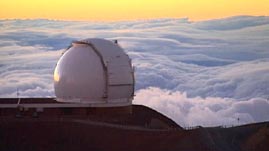Teachers' Domain - Digital Media for the Classroom and Professional Development
User: Preview

Source: PBS Hawaiʻi
Astronomical research is dependent on technology that allows astronomers to see the universe. Telescopes act as giant eyes, capturing the light from celestial objects and processing it for astronomers to study. Generally, a space-based telescope will offer the clearest views of the universe. However, astronomers have found an ideal site for ground-based telescopes. In this video segment adapted from First Light, learn about recent telescope technologies and one of the best ground locations — Mauna Kea.
To study the universe, astronomers rely on light that is gathered by telescopes — instruments and computers that are able to capture the electromagnetic radiation emitted from distant objects and process it for astronomers to study. Unfortunately, views from Earth's surface are restricted by Earth's atmosphere, so there are limitations to the light that ground-based telescopes can see.
Optical and radio wavelengths penetrate Earth's atmosphere with the least difficulty — the atmosphere is said to be transparent at these wavelengths. The upper atmosphere absorbs short-wavelength light, such as ultraviolet. Water vapor, found mainly in the lower part of the atmosphere, absorbs microwave and infrared light. However, the water vapor content quickly decreases with height, so if observatories are located at high elevations, the transparency for microwave and infrared light is greatly improved.
The atmosphere has other negative effects on light. Turbulence — the movement of air due to pressure and temperature variations — bends incoming light and causes fluctuations, a phenomenon that can be seen in the twinkling of stars. Dust and aerosols can also cause light to scatter. As a result, satellites located above the atmosphere are generally able to provide clearer and more detailed views of the universe than ground telescopes because they are free from both the distortion and the absorption effects of looking at the universe through air.
However, there are some ground locations that support high-quality observations. Mauna Kea in Hawaiʻi is an ideal site for astronomical telescopes. At 4,250 m (13,796 ft) above sea level, the telescopes on Mauna Kea are placed above much of the atmosphere, thereby minimizing the atmospheric effects. In addition, Mauna Kea is in the middle of an ocean, which results in very stable air over the mountain. The air is also very dry and typically free of clouds — providing an exceptionally high number of clear nights. The site is also far from heavily populated areas and the light pollution of city lights.
With over a dozen of the world's best telescopes situated on Mauna Kea — the largest infrared and optical telescopes and one radio telescope are located there — it is one of the world's leading astronomical observatories. Astronomers use the telescopes to research many different areas of astronomy — including the existence of new planets, the expansion of the universe, and black holes. Given the advancement of new technologies — such as adaptive optics — ground-based telescopes in optimal locations such as Mauna Kea may be able to rival space telescopes.
 Loading Standards
Loading Standards Teachers' Domain is proud to be a Pathways portal to the National Science Digital Library.
Teachers' Domain is proud to be a Pathways portal to the National Science Digital Library.
